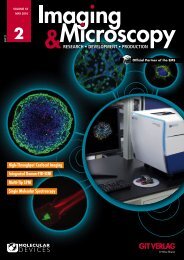SIM0216
You also want an ePaper? Increase the reach of your titles
YUMPU automatically turns print PDFs into web optimized ePapers that Google loves.
ELECTRON MICROSCOPY<br />
Stemming Unwanted Interference<br />
Resolution Improvement by Incoherent Imaging with ISTEM<br />
Florian Krause<br />
In Transmission Electron Microscopy (TEM) spatially incoherent image formation can have significant<br />
advantages regarding attainable resolution by removing unwanted interference effects. This<br />
has been exploited in the scanning TEM mode, which is incoherent but limited by other factors.<br />
Combining a scanning beam with the conventional TEM imaging mode can overcome these limitations.<br />
This method called ISTEM gives access to the advantages of both modes and facilitates an increase<br />
in resolution.<br />
From Traditional TEM to ISTEM<br />
High resolution Transmission Electron<br />
Microscopy (TEM) is one of the most important<br />
tools for the investigations of nanoscale<br />
structures. Historically, it has<br />
mostly been divided into two modes:<br />
For Conventional TEM (CTEM) the<br />
specimen is illuminated with a plane<br />
electron wave and then the image is<br />
formed by the objective lens of the microscope.<br />
For modern field emission sources<br />
the image formation is almost completely<br />
coherent here. Because a large area is illuminated,<br />
CTEM is influenced neither by<br />
the positioning precision of the incoming<br />
beam nor by aberrations of the probe<br />
forming lenses. Another advantage is the<br />
fact that though the size of the electron<br />
source has an influence on the images, it<br />
is not the factor limiting the resolution.<br />
Due to the coherence however, highresolution<br />
CTEM images can show complex<br />
interference patterns and hence be<br />
difficult to interpret. The high coherence<br />
also causes a strong dependence of the<br />
image pattern on the energy of the incident<br />
electrons. Chromatic aberration is<br />
therefore the limiting factor for resolution<br />
in CTEM.<br />
In the Scanning TEM (STEM) mode,<br />
the electron beam is focused onto the<br />
specimen. Then the intensity in a specific<br />
area of the diffraction pattern is<br />
recorded with an extended, usually circular<br />
or annular, detector. The image is<br />
formed by scanning over an area of the<br />
specimen. It can be shown that STEM is<br />
effectively an incoherent imaging mode<br />
due to the universal principle of reciprocity<br />
[1]. Therefore it is much more ro-<br />
40 • G.I.T. Imaging & Microscopy 2/2016



